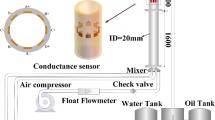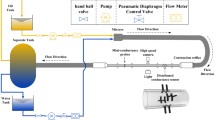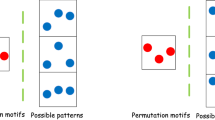Abstract
Multivariate time series are routinely measured in real complex systems, and effective multivariate multiscale methods for uncovering the complexity of multivariate complex systems are certainly needed. In this paper, a new complexity measure for multiscale analysis of multivariate time series, namely multivariate multiscale increment entropy (MMIE), is proposed and applied to detect the nonlinear dynamic complexity of flow pattern transition in oil–gas–water three-phase flow. The MMIE can map each increment into a word of two letters, which contains sign information and magnitude information, and make coupling analysis of multivariate time series. These endow the MMIE an ability to detect the complexity of multivariate time series. The simulation analysis of typical time series shows the importance of multiscale coupling analysis of multivariate time series and the effectiveness of MMIE in mining the complexity of different multivariate time series. Finally, the MMIE is employed to analyze the multichannel sensor signals of oil–gas–water three-phase flow system, which are of multivariate and correlated. The results indicate that MMIE can effectively reveal the dynamic complexity of different flow patterns and their evolution behavior with the change of flow condition.









Similar content being viewed by others
References
Cooper, K.D., Hewitt, G.F., Pinchin, B.: Photography of two-phase gas/liquid flow. J. Photo. Sci. 12, 269–278 (1964)
Fordham, E.J., Ramos, R.T., Holmes, A., Simonian, S., Huang, S.M., Lenn, C.: Multi-phase-fluid discrimination with local fiber-optical probes: III. Three-phase flows. Meas. Sci. Technol. 10, 1347–1352 (1999)
Parsi, M., Vieira, R.E., Torres, C.F., Kesana, N.R., Mclaury, B.S., Shirazi, S.A., Schleicher, E., Hampel, U.: Experimental investigation of interfacial structures within churn flow using a dual wire-mesh sensor. Int. J. Multiphas. Flow 73, 155–170 (2015)
Liu, L., Matar, O.K., Lawrence, C.J., Hewitt, G.F.: Laser-induced fluorescence (LIF) studies of liquid–liquid flows, Part I: flow structures and phase inversion. Chem. Eng. Sci. 61, 4007–4021 (2006)
Hu, B., Stewart, C., Hale, C.P., Lawrence, C.J., Hall, A.R.W., Zwiens, H., Hewitt, G.F.: Development of an X-ray computed tomography (CT) system with sparse sources: application to three-phase pipe flow visualization. Exp. Fluids 39, 667–678 (2005)
Roshani, G.H., Nazemi, E., Roshani, M.M.: Intelligent recognition of gas-oil-water three-phase flow regime and determination of volume fraction using radial basis function. Flow Meas. Instrum. 54, 39–45 (2017)
Fan, L.T., Neogi, D., Yashima, M., Nassar, R.: Stochastic analysis of a three-phase fluidized bed: fractal approach. AIChE J. 36, 1529–1535 (1990)
Niu, M.R., Liang, Q.F., Yu, G.S., Wang, F.C., Yu, Z.H.: Multifractal analysis of pressure fluctuation signals in an im**ing entrained-flow gasifier. Chem. Eng. Process. 47, 642–648 (2007)
Wu, B., Briens, L., Zhu, J.X.: Multi-scale flow behavior in gas–solids two-phase flow systems. Chem. Eng. J. 117, 187–195 (2006)
Zbilut, J.P., Webber Jr., C.L.: Embeddings and delays as derived from quantification of recurrence plots. Phys. Lett. A 171, 199–203 (1992)
Schinkel, S., Marwan, N., Dimigen, O., Kurths, J.: Confidence bounds of recurrence-based complexity measures. Phys. Lett. A 373, 2245–2250 (2009)
Vlahogianni, E.I., Karlaftis, M.G.: Comparing traffic flow time-series under fine and adverse weather conditions using recurrence-based complexity measures. Nonlinear Dyn. 69, 1949–1963 (2012)
Rosso, O.A., Larrondo, H.A., Martin, M.T., Plastino, A., Fuentes, M.A.: Distinguishing noise from chaos. Phys. Rev. Lett. 99, 154102 (2007)
Wang, Y.Y., Shang, P.J., Liu, Z.L.: Analysis of time series through complexity–entropy curves based on generalized fractional entropy. Nonlinear Dyn. 96, 585–599 (2019)
Peng, C.K., Havlin, S., Stanley, H.E., Goldberger, A.L.: Quantification of scaling exponents and crossover phenomena in nonstationary heartbeat time series. Chaos 5, 82–87 (1995)
Kantelhardt, J.W., Zschiegner, S.A., Koscielny-Bunde, E., Havlin, S., Bunde, A., Stanley, H.E.: Multifractal detrended fluctuation analysis of nonstationary time series. Phys. A 316, 87–114 (2002)
Tiwari, A.K., Albulescu, C.T., Yoon, S.M.: A multifractal detrended fluctuation analysis of financial market efficiency: comparison using Dow Jones sector ETF indices. Physica A 483, 182–192 (2017)
Podobnik, B., Stanley, H.E.: Detrended cross-correlation analysis: a new method for analyzing two non-stationary time series. Phys. Rev. Lett. 100, 084102 (2007)
Jiang, Z.Q., Zhou, W.X.: Multifractal detrending moving-average crosscorrelation analysis. Phys. Rev. E 84, 016106 (2011)
Yuan, N.M., Fu, Z., Zhang, H., Lin, P., Elena, X., Juerg, L.: Detrended partial-crosscorrelation analysis: a new method for analyzing correlations in complex system. Sci. Rep. 5, 08143 (2015)
Yan, C., Zhai, L.S., Zhang, H.X., Wang, H.M., **, N.D.: Cross-correlation analysis of interfacial wave and droplet entrainment in horizontal liquid-liquid two-phase flows. Chem. Eng. J. 320, 416–426 (2017)
Pincus, S.M.: Approximate entropy as a measure of system complexity. Proc. Natl. Acad. Sci. USA 88, 2297–2301 (1991)
Richman, J.S., Moorman, J.R.: Physiological time-series analysis using approximate entropy and sample entropy. Am. J. Physiol Heart C. 278, 2039–2049 (2000)
Costa, M., Goldberger, A.L., Peng, C.K.: Multiscale entropy analysis of complex physiologic time series. Phys. Rev. Lett. 89, 068102 (2002)
Thuraisingham, R.A., Gottwald, G.A.: On multiscale entropy analysis for physiological data. Phys. A 366, 323–332 (2006)
Yan, R., Yang, Z., Zhang, T.: Multiscale cross entropy: a novel algorithm for analyzing two time series, In: Proceedings of the 5th International Conference on Natural Computation, pp. 411–413 (2009)
Wang, D.Y., **, N.D., Han, Y.F., Wang, F.: Measurement of gas phase characteristics in vertical oil-gas-water slug and churn flows. Chem. Eng. Sci. 177, 53–73 (2018)
Bandt, C., Pompe, B.: Permutation entropy: a natural complexity measure for time series. Phys. Rev. Lett. 88, 174102 (2002)
Liu, X.F., Wang, Y.: Fine-grained permutation entropy as a measure of natural complexity for time series. Chin. Phys. B 18, 2690–2695 (2009)
Fadlalah, B., Chen, B.D., Keil, A., Príncipe, J.: Weighted-permutation entropy: a complexity measure for time series incorporating amplitude information. Phys. Rev. E 87, 022911 (2013)
Liu, X.F., Jiang, A.M., Xu, N., Xue, J.R.: Increment entropy as a measure of complexity for time series. Entropy 18, 22–35 (2016)
Liu, X.F., Wang, X., Zhou, X., Jiang, A.M.: Appropriate use of the increment entropy for electrophysiological time series. Comput. Biol. Med. 95, 13–23 (2018)
Ahmed, M.U., Mandic, D.P.: Multivariate multiscale entropy: a tool for complexity analysis of multichannel data. Phys. Rev. E 84, 061918 (2011)
Yin, Y., Shang, P.J.: Multivariate multiscale sample entropy of traffic time series. Nonlinear Dyn. 86, 479–488 (2016)
Gao, Z.K., Yang, Y.X., Zhai, L.S., Ding, M.S., **, N.D.: Characterizing slug to churn flow transition by using multivariate pseudo Wigner distribution and multivariate multiscale entropy. Chem. Eng. J. 291, 74–81 (2016)
Morabito, F.C., Labate, D., Foresta, F.L., Bramanti, A., Morabito, G., Palamara, I.: Multivariate multi-scale permutation entropy for complexity analysis of Alzheimer’s disease EEG. Entropy 14, 1186–1202 (2012)
Yin, Y., Shang, P.J.: Multivariate weighted multiscale permutation entropy for complex time series. Nonlinear Dyn. 88, 1707–1722 (2017)
Han, Y.F., **, N.D., Zhai, L.S., Ren, Y.Y., He, Y.S.: An investigation of oil–water two-phase flow instability using multivariate multi-scale weighted permutation entropy. Phys. A 518, 131–144 (2019)
Wang, D.Y., **, N.D., Zhai, L.S., Ren, Y.Y.: Characterizing flow instability in oil-gas-water three-phase flow using multi-channel conductance sensor signals. Chem. Eng. J. (2019). https://doi.org/10.1016/j.cej.2019.03.113
Wang, D.Y., **, N.D., Zhuang, L.X., Zhai, L.S., Ren, Y.Y.: Development of a rotating electric field conductance sensor for measurement of water holdup in vertical oil-gas-water flows. Meas. Sci. Technol. 29, 075301 (2018)
Acknowledgements
This study was supported by the National Natural Science Foundation of China (Grant Nos. 51527805, 11572220).
Author information
Authors and Affiliations
Corresponding author
Ethics declarations
Conflict of interest
The authors declare that they have no conflict of interest concerning the publication of this manuscript.
Additional information
Publisher's Note
Springer Nature remains neutral with regard to jurisdictional claims in published maps and institutional affiliations.
Rights and permissions
About this article
Cite this article
Wang, D., **, N. Multivariate multiscale increment entropy: a complexity measure for detecting flow pattern transition in multiphase flows. Nonlinear Dyn 100, 3853–3865 (2020). https://doi.org/10.1007/s11071-020-05733-0
Received:
Accepted:
Published:
Issue Date:
DOI: https://doi.org/10.1007/s11071-020-05733-0




